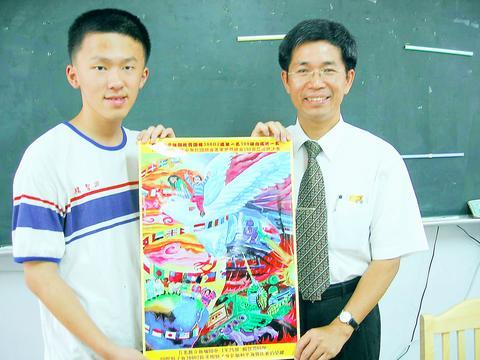The UN Postal Administration (UNPA) has dismissed allegations that it succumbed to pressure from Beijing to abandon a Taiwanese boy's design that was thought to have been selected for printing in a competition to create a special postage stamp.
In addition to expressing its regret, the UNPA offered an explanation on its Web site about how designs were selected and what the "actual reasons" were which led to the "misunderstanding."

PHOTO: HO YU-HUA, TAIPEI TIMES
The UNPA said in a statement that it selected designs through its Stamp Advisory Committee, made up of 10 members from its New York, Geneva and Vienna offices. In this case, the committee shortlisted eight designs from the 24 merit award winners of the Lions Clubs International's competition to design a peace poster.
One of the eight shortlisted entrants was Yang Chih-yuan (
The UNPA said that printed proofs were made in order to see all eight designs at stamp size so that the reproduction quality could be determined. The advisory committee selected six designs for the UNPA's Peace Stamps series, which is to be issued on Sept. 21.
Yang's design was not among the final six.
"However, due to an internal misunderstanding and miscommunication, Mr. Yang's proof got publicized in error as one of the six stamps intended to be issued," the statement said. "This error was detected and hence a corrective broadcast has been made."
The statement contradicts local media reports, which claimed that Yang's painting had been selected to be circulated as a commemorative stamp, but was disqualified following objections from China.
China's protest was reportedly triggered by the national flag of Taiwan being shown in the boy's design. In the picture, two children are riding a dove, symbolizing the escape from war and progress toward a peaceful nation. The right side of the painting shows a scene of war, with homeless children crying amid looming tanks, while the left side shows a joyful earth painted in vivid colors.
A spiral resembling a strand of DNA and comprising national flags winds around the dove. The ROC flag is among them.
Yang said that his painting was inspired by the Sept. 11 terrorist attacks in the US.
Following the incident, the Ministry of Foreign Affairs issued a statement criticizing China's apparent intervention.
The Taiwan chapter of the Lions has conveyed its protest to the UN over the issue.
The chapter's lawyers have also been looking into the legal issues involved in authorizing the local circulation of Yang's design as a stamp.
Postal authorities have suggested using Yang's painting on a stamp in Taiwan, pending authorization from the Lions Clubs International, which holds the copyright to the design.
The Presidential Office has also suggested that Yang's design be issued as a stamp.
If the authorization is granted, it will be the first design by a student to be published as a stamp in Taiwan. In the past, only the work of well-known artists has been used.

Taiwan is to commence mass production of the Tien Kung (天弓, “Sky Bow”) III, IV and V missiles by the second quarter of this year if the legislature approves the government’s NT$1.25 trillion (US$39.78 billion) special defense budget, an official said yesterday. Commenting on condition of anonymity, a defense official with knowledge of the matter said that the advanced systems are expected to provide crucial capabilities against ballistic and cruise missiles for the proposed “T-Dome,” an advanced, multi-layered air defense network. The Tien Kung III is an air defense missile with a maximum interception altitude of 35km. The Tien Kung IV and V

The disruption of 941 flights in and out of Taiwan due to China’s large-scale military exercises was no accident, but rather the result of a “quasi-blockade” used to simulate creating the air and sea routes needed for an amphibious landing, a military expert said. The disruptions occurred on Tuesday and lasted about 10 hours as China conducted live-fire drills in the Taiwan Strait. The Civil Aviation Administration (CAA) said the exercises affected 857 international flights and 84 domestic flights, affecting more than 100,000 travelers. Su Tzu-yun (蘇紫雲), a research fellow at the government-sponsored Institute for National Defense and Security Research, said the air

Taiwan lacks effective and cost-efficient armaments to intercept rockets, making the planned “T-Dome” interception system necessary, two experts said on Tuesday. The concerns were raised after China’s military fired two waves of rockets during live-fire drills around Taiwan on Tuesday, part of two-day exercises code-named “Justice Mission 2025.” The first wave involved 17 rockets launched at 9am from Pingtan in China’s Fujian Province, according to Lieutenant General Hsieh Jih-sheng (謝日升) of the Office of the Deputy Chief of the General Staff for Intelligence at the Ministry of National Defense. Those rockets landed 70 nautical miles (129.6km) northeast of Keelung without flying over Taiwan,

City buses in Taipei and New Taipei City, as well as the Taipei MRT, would on Saturday begin accepting QR code payments from five electronic payment providers, the Taipei Department of Transportation said yesterday. The new option would allow passengers to use the “transportation QR code” feature from EasyWallet, iPass Money, iCash Pay, Jkopay or PXPay Plus. Passengers should open their preferred electronic payment app, select the “transportation code” — not the regular payment code — unlock it, and scan the code at ticket readers or gates, General Planning Division Director-General Liu Kuo-chu (劉國著) said. People should move through the